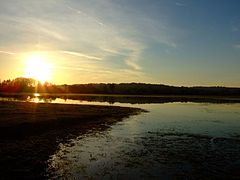
Wolvercote is a village that is part of the City of Oxford, England. It is about 3 miles (5 km) northwest of the city centre, on the northern edge of Wolvercote Common, which is itself north of Port Meadow and adjoins the River Thames.

Binsey is a small village on the west side of Oxford, in Oxfordshire, England. It lies on the banks of the River Thames about 1.5 miles (2.4 km) northwest of the centre of Oxford, on the opposite side of the river from Port Meadow and about 1 mile (1.6 km) southwest of the ruins of Godstow Abbey.

Godstow is a hamlet about 2.5 miles (4 km) northwest of the centre of Oxford. It lies on the banks of the River Thames between the villages of Wolvercote to the east and Wytham to the west. The ruins of Godstow Abbey, also known as Godstow Nunnery, are here. A bridge spans the Thames and the Trout Inn is at the foot of the bridge across the river from the abbey ruins. There is also a weir and Godstow lock.

The Trout Inn is a historic pub in Lower Wolvercote north of Oxford, close to Godstow Bridge, directly by the River Thames.

Osney Lock is a lock on the River Thames in Oxford, England, where the village or island of Osney is next to the river.

Godstow Lock is a lock on the River Thames in Oxfordshire, England. It is between the villages of Wolvercote and Wytham on the outskirts of Oxford. The first lock was built of stone by Daniel Harris for the Thames Navigation Commission in 1790. It is the lock furthest upstream on the river which has mechanical (electro-hydraulic) operation - every lock upstream of Godstow utilises manual beam operation instead.
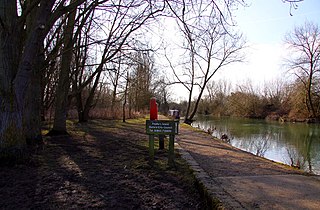
Fiddler's Island is an island in the River Thames at Oxford in England. It is situated south of Port Meadow on the reach above Osney Lock.

Castle Mill Stream is a backwater of the River Thames in the west of Oxford, England. It is 5.5 km long.
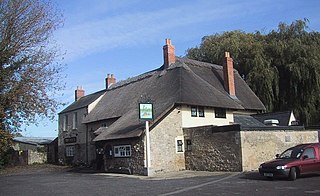
The Perch is a historic public house in the village of Binsey, Oxfordshire, England, northwest of Oxford and close to the River Thames, overlooking Port Meadow.
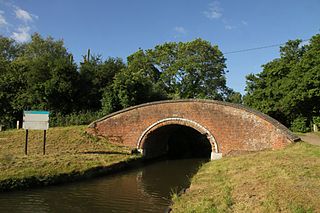
Duke's Cut is a short waterway in Oxfordshire, England, which connects the Oxford Canal with the River Thames via the Wolvercote Mill Stream. It is named after George Spencer, 4th Duke of Marlborough, across whose land the waterway was cut. It is seen as a branch of the Oxford Canal.

Aristotle Lane is a road in north Oxford, England.

Castle Mill is a graduate housing complex of the University of Oxford in Oxford, England.

Cripley Meadow lies between the Castle Mill Stream, a backwater of the River Thames, and the Cotswold Line railway to the east, and Fiddler's Island, on the main branch of the Thames to the west, in Oxford, England. It is to the south of the better known Port Meadow, a large meadow of common land. To the south is Sheepwash Channel which connects the Oxford Canal with the River Thames.

Longcross was a British construction company which entered into administration in June 2015. The head office was based in Ashtead, Surrey, England.
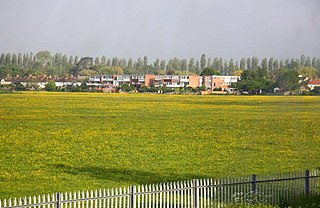
Wolvercote Common is an area of grassed common land north of Port Meadow in Oxford, England.

"Binsey Poplars" is a poem by Gerard Manley Hopkins (1844–1889), written in 1879. The poem was inspired by the felling of a row of poplar trees near the village of Binsey, northwest of Oxford, England, and overlooking Port Meadow on the bank of the River Thames. The replacements for these trees, running from Binsey north to Godstow, lasted until 2004, when replanting began again.
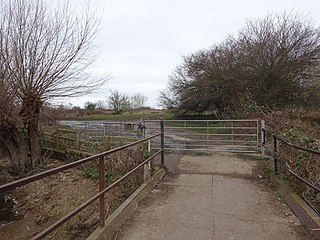
Burgess Field Nature Park is a nature reserve next to Port Meadow, Oxford, in Oxfordshire, England, managed by Oxford City Council.

The Trap Grounds is a nature reserve in north Oxford, Oxfordshire, England, owned by Oxford City Council.

Port Meadow with Wolvercote Common and Green is a 167.1-hectare (413-acre) biological Site of Special Scientific Interest in Oxford in Oxfordshire. It is a Nature Conservation Review site, Grade I, and part of Oxford Meadows Special Area of Conservation. The remains of Godstow Abbey, which is a Scheduled Monument, are in the north of the site.

Wolvercote Meadows is a 7.1-hectare (18-acre) biological Site of Special Scientific Interest north of Oxford in Oxfordshire. Part of it is owned by the Oxford Preservation Trust. It is part of Oxford Meadows Special Area of Conservation.
